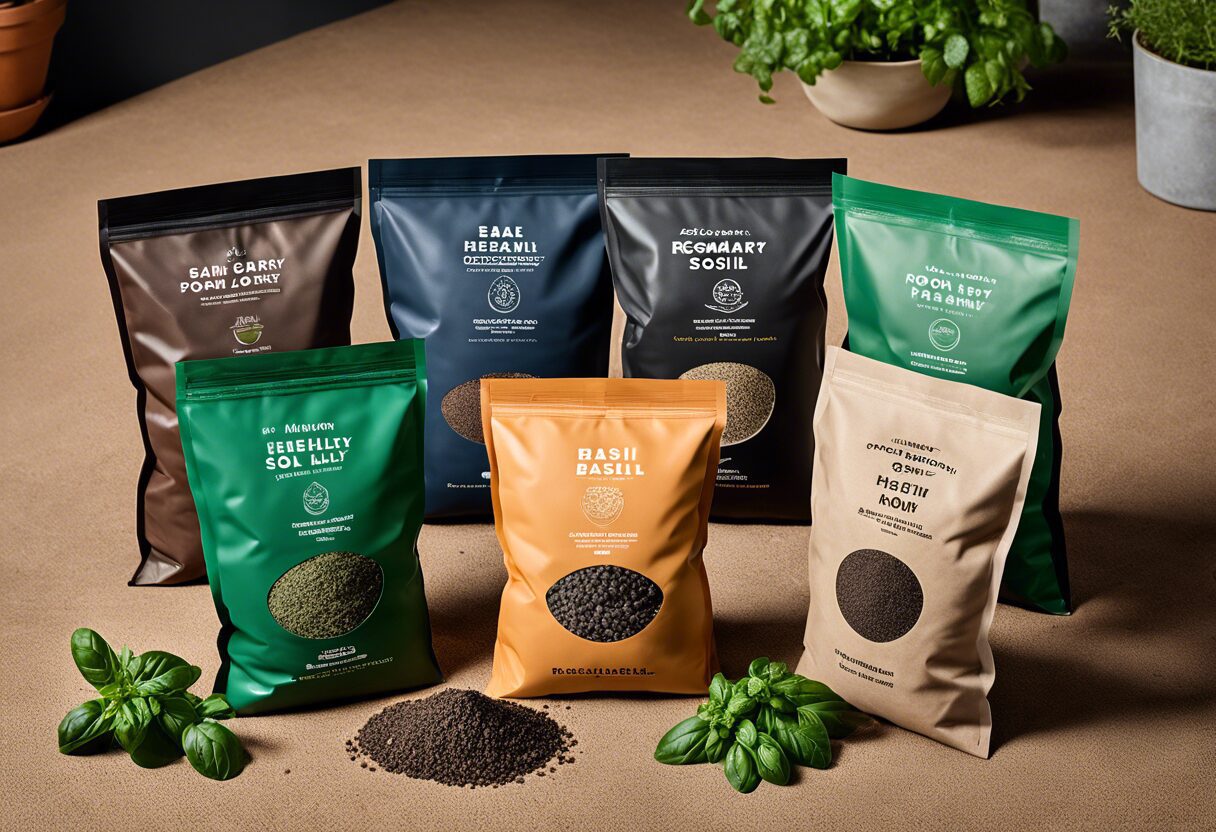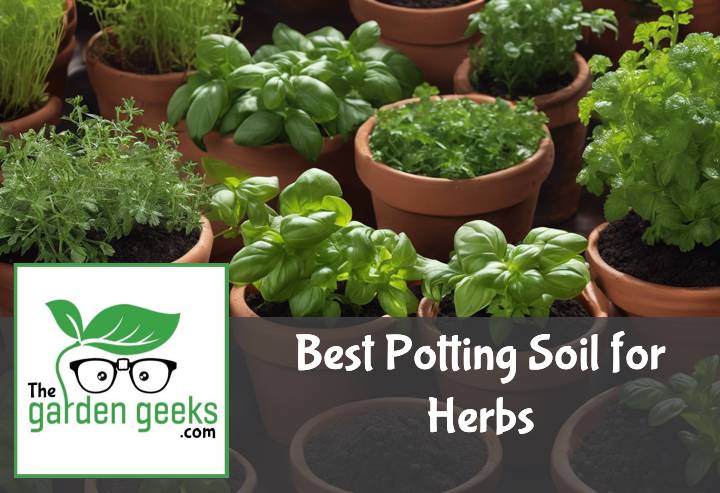Ever tried to grow herbs, but they ended up looking more like a wilted salad than the lush garden you envisioned? Well, my friend, it might not be your nonexistent green thumb at fault here. It could be that you’re using the wrong soil. Yep, you heard me right. Not all soil is created equal, especially when it comes to growing herbs. And that’s where Best Potting Soil for Herbs comes into play.
But don’t worry! I’m here to help you navigate through this muddy situation (pun intended). So buckle up and let’s dive deep into the world of potting soils and figure out which one will give your herbs the best chance at life. Keep reading about Best Potting Soil for Herbs (With Examples).
Key Takeaways
- The best potting soil for herbs is well-draining, fertile, and slightly acidic.
- FoxFarm Ocean Forest Potting Soil is recommended due to its rich composition and pH balance.
- Espoma Organic Potting Mix is another good choice as it contains myco-tone, promoting root growth.
- Miracle-Gro Nature’s Care Organic & Natural Potting Mix provides moisture control.
- DIY option: mix equal parts of compost, coarse sand, and peat moss. Add lime if needed to adjust pH.

What is Potting Soil and Why is it Important for Herbs?
Potting soil, or as some gardeners like to call it, “black gold,” is a gardener’s best friend when it comes to herb cultivation. It’s the unsung hero that plays a pivotal role in the growth and health of your herbs.
The Role of Potting Soil in Herb Growth
Potting soil isn’t just dirt from your backyard. Oh no, it’s much more than that! It’s a nutrient-rich medium that provides all the essential nutrients your herbs need to grow healthy and strong. Nutrient supply? Check! Root development? Double check!
Now, let’s talk about roots. They’re like the herb’s personal food delivery service, transporting nutrients from the soil straight to the plant. And guess what? Good potting soil makes sure this delivery service runs smoothly.
Key Components of High-Quality Potting Soil
So what makes potting soil so special? Well, high-quality potting soil has several key components that make it perfect for growing herbs. First off, it has a good amount of organic matter content which helps retain moisture and nutrients.
Then there’s pH balance – an often overlooked but crucial aspect of potting soil. A balanced pH ensures your herbs can absorb all those yummy nutrients effectively.
And let’s not forget about drainage! Too much water can lead to root rot – not exactly ideal for your herbs’ health. So quality potting soils have elements that promote good drainage while still retaining enough moisture for the plants’ needs.
In short, choosing the best potting soil for herbs isn’t just about grabbing a bag off a shelf; it’s about understanding what makes up that black gold and how it contributes to your herb garden’s success.
How to Choose the Best Potting Soil for Herbs?


Choosing the best potting soil for herbs is like picking a comfy bed for your plants. It’s about finding that perfect mix that supports herb growth and keeps them happy. Let’s dive into different soil types and what you should consider when selecting potting soil.
Understanding Different Types of Soils
First stop, let’s talk about loamy soil. This guy is like the VIP in the world of soils, loved by many gardeners. It has a balanced mix of sand, silt, and clay, providing good drainage while retaining enough moisture for your herbs.
Next up is sandy soil. Think of it as the free spirit among soils – loose and fast-draining. But beware! It might drain water too quickly for some herbs’ liking.
Then we have clayey soil. This one’s like that clingy friend who holds onto everything – including water and nutrients. Great for nutrient-loving herbs but can be a bit too heavy and slow-draining.
Don’t forget about peat moss and perlite, these two are often added to potting mixes to improve water retention and aeration respectively.
Factors to Consider When Choosing Potting Soil for Herbs
Now onto the nitty-gritty of choosing your potting mix. First off, look out for a nutrient-rich soil because your herbs need food too! A good mix should have plenty of organic matter content to keep those green babies well-fed.
Next up is checking the pH balance in soil. Most herbs prefer slightly acidic to neutral pH levels so keep an eye on this one!
Drainage properties are also crucial when selecting potting soil for your herbs. You want something that provides good drainage but also retains enough moisture – think Goldilocks, not too dry, not too wet!
Lastly, consider the water retention capacity of the soil. Some herbs love a good drink while others prefer to stay on the drier side. So, choose a mix that suits your specific herb’s thirst level!



Examples of Best Potting Soils for Specific Herbs
Herb gardening is a bit like matchmaking. You’ve got to pair each herb with its perfect potting soil partner. Let’s dive into the best potting soil for herbs and find the ideal match for basil, rosemary, thyme, and parsley.
Best Potting Soil for Basil
Basil is a bit of a diva in the herb world. It loves rich, well-draining soil that can keep up with its thirst but won’t leave it waterlogged. A basil potting mix should be like a five-star hotel buffet – packed with nutrients!
It’s all about balance here. Too much water and your basil might drown, too little and it could dry out. That’s why a rich compost for basil is essential to keep this green gourmet happy.
Best Potting Soil for Rosemary
Rosemary, on the other hand, prefers a more Spartan lifestyle. This Mediterranean native thrives in well-drained soils that mimic its natural habitat. Think sandy beaches rather than lush rainforests when choosing a rosemary growing medium.
A good rule of thumb? If your soil would make a decent sandcastle, it’s probably not right for rosemary. Instead, opt for something grittier like a sandy loam for rosemary that drains quickly.
Best Potting Soil for Thyme
Thyme likes to march to the beat of its own drum…or pH scale in this case. Unlike most herbs which prefer neutral or slightly acidic soils, thyme has an affinity towards alkaline conditions.
So what does this mean when choosing your thyme growing medium? Well, you’ll want something light-weight but also rich in alkaline elements. An alkaline-rich soil mix will help your thyme thrive without making it feel weighed down.
Best Potting Soil for Parsley
Last but not least, let’s talk parsley. This herb is a bit of a Goldilocks when it comes to soil – it likes conditions that are just right. Too sandy and it’ll dry out, too clayey and it’ll get waterlogged.
The key here is finding a parsley potting mix that’s rich in organic matter but also well-draining. A rich compost for parsley will provide the nutrients this herb needs while ensuring excess water can escape. It’s all about balance with parsley!
Common Mistakes to Avoid When Choosing and Using Potting Soil
When it comes to using the best potting soil for herbs, folks often trip up on a few common errors. We’re talking about things like watering, pH levels, and fertilization. Let’s dive into these potting soil mistakes and see how you can avoid them in your own herb gardening.
Overwatering or Underwatering
First off, we’ve got watering. It’s a bit of a Goldilocks situation – too much or too little can both spell disaster for your herbs. Overwatering your plants can lead to root rot, while underwatering can leave them parched and wilted. It’s all about finding that sweet spot of moisture balance in the soil.
Now, I know what you’re thinking: “How am I supposed to know when it’s just right?” Well, most herbs prefer slightly damp (but not soggy) soil. If the top inch of soil is dry, it’s time to water. Remember, improper watering can have some serious effects on your plants’ health.
Ignoring pH Levels
Next up is pH levels – another thing gardeners often overlook when choosing their potting mix. You see, herbs aren’t big fans of overly acidic or alkaline soils. They prefer something more neutral.
Monitoring pH levels is crucial for optimal herb growth. If the pH is off-kilter, your plants might struggle to absorb nutrients from the soil – which ain’t good news for anyone involved! So keep an eye out for signs of distress like yellow leaves or stunted growth; they could be telling you that your soil’s pH needs adjusting.
Neglecting Fertilization
Finally, let’s talk fertilization – or rather, the lack thereof. Many people think that once they’ve planted their herbs in some high-quality potting soil, their job is done. But that’s not quite the case.
You see, even the best potting soil for herbs can’t provide all the nutrients your plants need indefinitely. Over time, those nutrients get used up and need to be replenished. That’s where fertilization comes in.
Neglecting to feed your plants can lead to poor growth and lackluster flavor – which is a real bummer if you’re growing culinary herbs! So don’t skimp on the plant food, folks. Your herbs will thank you for it.


To Wrap Up
So, we’ve dug deep into the garden of knowledge to unearth the secrets of the Best Potting Soil for Herbs. It’s like finding the perfect pair of jeans – once you’ve found it, your herbs will be strutting their stuff in style!
Remember, your herbs are like hipsters at a coffee shop; they need just the right environment to thrive. So, don’t forget to give them the VIP treatment with top-notch soil!


